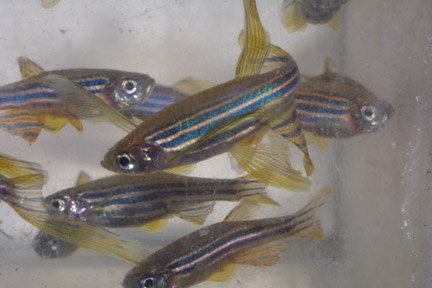Progress has been made towards creating a new zebrafish model of FSH to investigate the effect of DUX4 on the ability of muscle stem cells to repair muscle. Creation of this zebrafish model requires development of a complex genetic tool which allows scientists to switch on DUX4 specifically in muscle stem cells. The genetic tool also includes fluorescent proteins to mark muscle stem cells that have DUX4 switched on with yellow fluorescence. This will help the researchers to easily identify these cells when studying them under a fluorescent microscope.
The researchers have successfully engineered three components of this genetic tool, which will now be combined to create the final product. The next stage will be to inject this genetic tool into zebrafish to create genetically modified fish. DUX4 can then be turned on in muscle stem cells in these fish to study how this affects the ability of these cells to repair muscle.
Camilla Farnetani, the PhD student working on this project, presented a poster of her work at our 2018 National Conference.
What are the aims of the project?
Activation of the DUX4 protein is thought to cause muscle wasting and inflammation in people with facioscapulohumeral muscular dystrophy (FSHD). How DUX4 does this is not fully understood, but previous studies have shown that it affects the ability of muscle stem cells to repair damaged muscle. This research has mostly been carried out in cells grown in the laboratory (in vitro), so how this affects muscle stem cells in living people is not understood.
Dr Robert Knight and his PhD student are aiming to understand how DUX4 affects muscle stem cell function in a whole, living animal (in vivo), the zebrafish. They will create a new zebrafish model of FSHD, where DUX4 is specifically switched on inside muscle stem cells. They will see how this affects the ability of the muscle stem cells to repair muscle, by studying them under a powerful fluorescent microscope.
The researchers will also investigate the immune response following injury to the muscle of the zebrafish models. This will help to explain how DUX4 activity contributes to muscle inflammation in FSHD and how this might affect muscle strength.
In the final part of this PhD studentship, the researchers will investigate the role of an enzyme called Ret in FSHD. They will test a series of drugs that inhibit Ret in the zebrafish model. This builds on a previous MDUK-funded study, where Dr Knight and Professor Peter Zammit found that an existing Ret inhibitor, sunitinib, improved the development of muscle cells with FSHD that were grown in a dish (in vitro). In this new project, they will see if sunitinib can improve muscle regeneration in the zebrafish model (in vivo).
Why is this research important?
Although we know that DUX4 activity is the underlying cause of FSHD, it is currently not clear whether DUX4 acts inside the muscle fibres or inside the muscle stem cells. This project will help to clarify this by developing a new animal model where DUX4 is specifically active in the muscle stem cells. This will improve our understanding of how DUX4 affects muscle stem cell function, and how this might lead to muscle wasting in FSHD.
How will the outcomes of this research benefit people with FSHD?
This project will improve our understanding of FSHD, which is essential for the development of effective treatments in future. The researchers are investigating whether sunitinib – a drug already approved for the treatment of some cancers – could improve muscle regeneration in the zebrafish model. If successful, this drug could be repurposed for the treatment of FSHD and enter clinical trials relatively quickly.
How might this research impact on other neuromuscular conditions?
Zebrafish have many benefits over mouse models. Immature zebrafish (larvae) are completely transparent, which mean it is easy to fluorescently label and visualise the muscle stem cells in live fish under a microscope. And because they live in water, zebrafish are also easily treated with drugs, making them a powerful model for testing potential therapies that promote muscle repair. Many zebrafish models for neuromuscular conditions have been created, allowing scientists to better understand what happens to the muscle and stem cells as the condition progresses. The experimental techniques used in this project will be helpful for scientists studying muscle stem cell function in zebrafish models for other muscle-wasting conditions.
Grant information
Project leader: Dr Robert Knight
Institute: King’s College London
Condition: Facioscapulohumeral muscular dystrophy (FSHD)
Duration: Four years (PhD studentship)
Total cost (£): 113,417
Official title: Modelling of DUX4-induced pathophysiology and screening for pharmacological therapies in a novel zebrafish model of fascioscapulohumeral dystrophy

It is only through your contributions that we can continue to fund the vital work that takes us closer to finding treatments and cures for muscle-wasting conditions. Donate now and help change the lives of thousands of people living with these conditions. Thank you for your support.
